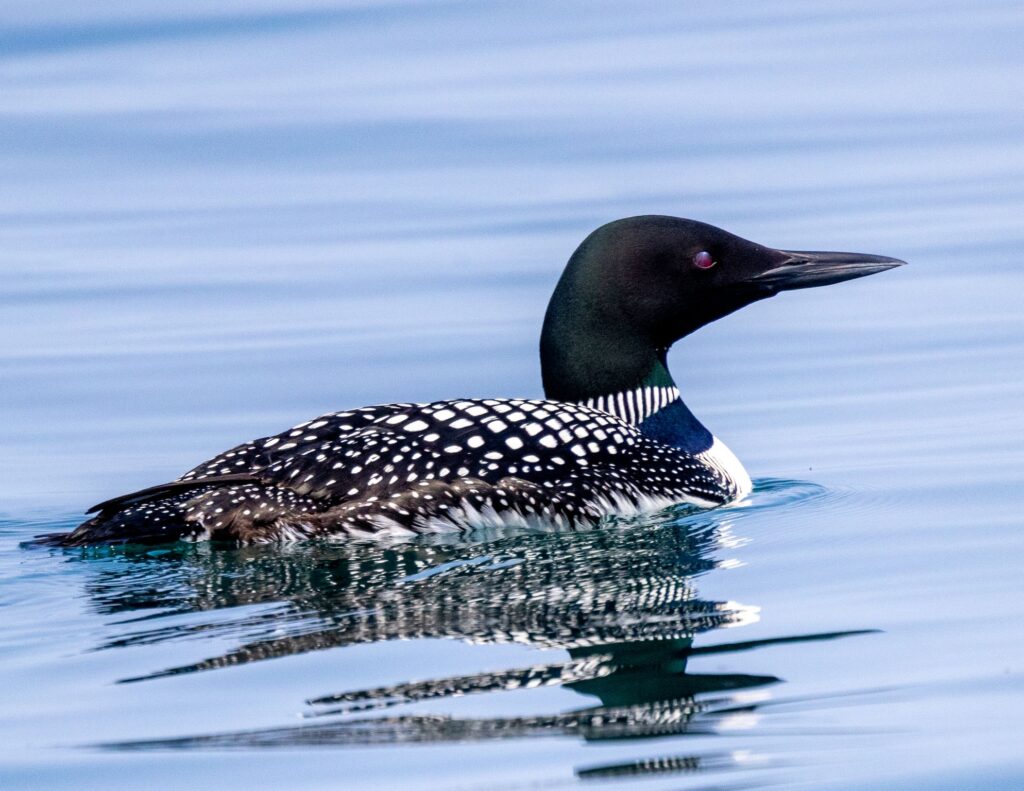Feathered Friends by Sherrie Versluis
Living in Canada is a great thing for nature lovers. We are so fortunate to have such a diverse amount of habitat to be able to enjoy everything Mother Nature has to offer. Almost everyone has at some point gone ‘to the lake’. There’s nothing like heading out to cottage country to go swimming, fishing, or to just relax and de-stress. One of the most well known trademarks of our lakes is the haunting call of the Common Loon. So popular is the loon that its image adorns the Canadian one dollar coin known of course as the Loonie. The beautiful call of the loon is one of total serenity and peace. Sadly, this peaceful tune has become one that is heard less and less each year. Fossil evidence shows loons have been around for about 50 million years with the earliest species of loon found in Scotland. Other loon fossils were discovered in France, Italy, Czechoslovakia, and in North America. The Common Loon of today is thought to have evolved over 10 million years ago.

Loons have been revered by humans as far back as history can show and many cultures have honoured the loon. There are many legends and beliefs like that of the ancient Indian tribes of North America who, believe that the loon would guide the soul of the dead to a new world. The ancient Inuit of Alaska had elaborate burials for loons which included adorning the skull with ivory eyes. One legend is that loons have the ability to give sight to those who are blind by taking them to the bottom of the lake many times until vision is restored. It is said that the white banding around the neck of the loon is a white necklace of shells that was a gift of gratitude from someone whose eyesight returned. Another Indigenous legend says the loon has magical powers and at the beginning of creation, the loon would dive down to the bottom of the lake floor and bring up mud for the Creator to make the earth.
As the Industrial revolution began, man’s love and respect for the loon took a tragic turn. The loon was one of the first creatures to show signs of the damage of acid rain and was a poster picture for the effects of oil spills on birds. Fishing nets and lines along with lead weights caused many loons to suffer drowning and poisonings. Pesticides and chemicals are known to have damaging effects to loons and their food sources. Early Europeans arrived in North America and hunted loons to the point of major decline. Shooting loons was a big sport due to the challenge of trying to get a diving bird. Later, loons were considered competition to fisherman so many were culled.
Some interesting facts of the Common loon is, they dive to depths of an amazing 230 feet, have a lifespan of 30 years, and require a lake size of at least 12 acres to nest. They are about 3 feet in length and weigh in the area of 12 pounds. Loons do not start nesting until the age of 6 when in late May 1-2 eggs are laid. Both parents take part in the incubation, always staying close to the nest unless of a major disturbance. Eggs hatch in 29 days and the young will stay with their parents for the rest of the summer. The ‘Yodel’ call of the loon announces territory, the ‘tremolo-call’ is described as an alarm call, and the ‘wail-call’ is a form of contact between a pair.
Thankfully, the loon population is considered stable today but is still closely monitored. Hunting loons is a thing of the past and some fishing regulations have changed to hopefully save them from harm. Still there are many environmental issues like inconsistent lake levels affecting nesting success and oil spills that continue to hinder loon populations. You can help by becoming a member of Birds Canada and taking part in the Canadian Lakes Loon Survey. The information you can provide is very helpful in finding out much needed information about the Common loon population. By just observing loons around your cottage you can be a part of important research. You can even be part of preserving some of the most beautiful, mystical music from a bird of many legends, an irreplaceable piece of Canadian lake landscapes, the Common loon. Go to birdscanada.org today to get your survey package and be part of monitoring Loons around your area to help learn more about their declining populations.
Sherrie Versluis owns the Preferred Perch and is an avid birder.

